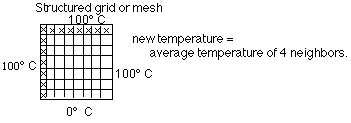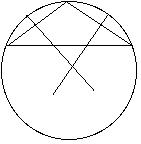out degree can be n-1

| Instructor: Scot Drysdale | July 2, 1996 |
| Nearest Neighbor graph out degree can be n-1 |
 |
 |
in degree can be 6 if the points are in a circle around a center point. |
| Cannot be > 6. Suppose that point A had an in-degree > 6. Then A must have two adjacent neighbors less than 60 apart. Call them B and C. One of the angles in the triangle ABC must be > 60 , because the angle at A is < 60 and there are 180 in the triangle. Without loss of generality we can assume that it is the angle at B. The edge opposite B must be longer than the edge opposite A, so C is then closer to B than to A. This contradicts the assumption that A was B's nearest neighbor. |  |
| (perhaps the average of the edge values, or the temperature of the nearest edge value, or anything else. The choice of initial values affects the speed with which the process converges to a fixed set of values, but not the final solution.) |  |
| Cross section of an airplane - Laminar flow - smooth flow of air over the wing. Turbulence - chaotic behavior of air flow caused by the interaction of the air with the wing. |
 |
Given points A, B, and C is C left of  Signed area of triangle ABC Sign + for counterclockwise orientation Sign - for clockwise orientation |
 |

3D tetrahedron

| How do you find the center of a circle? Compute the perpendicular bisector lines and find their intersection. Compare the radius of the circle to the distance of the point to determine if the point is out of the circle, in the circle or on the circle. Or you can actually convert this to a test of whether a point is above, below, or on a plane. |  |
To see how this happens, we consider the simpler 1-dimensional betweeness test. If
[a, b] is an interval on the x-axis, we want to know if point c lies between them.
This is easy to test directly, but can be converted to a question of whether a point
is left of or right of a line. Map each of a, b, and c up onto the parabola f(x) = x2. That is, map a onto the point (a, a2), b onto the point (b, b2), and c onto the point (c, c2). Note that if c is between a and b it will map onto the "bulge" of the parabola
below the ray ab, so will be right of ab. If it is outside of [a, b] it will map
to a point to the left of ab.
The same idea generalizes to higher dimensions. In 2 dimensions, to test if a point
is within a circle through three other points, we lift them onto the parabola of
rotation by mapping (x, y) onto (x, y, x2 + y2). Points within the circle map below the plane through the three lifted points and
points outside of the parabola map to points above the plane. (Slide 3)
The intersection of the plane with the parabola of rotation will produce an ellipse
that projects into a circle on the xy plane.

This observation gives us a different way of computing the Delaunay triangulation.
If n points in the xy plane are lifted onto the paraboloid of rotation and their
convex hull is computed in 3-D, faces of that convex hull will generally be triangles.
Each face is contained in a plane of support - a plane that goes through the points on
that face and has all other points to one side of it. Note that if all points are
above such a plane, then the circle in xy defined by the three original points must
be empty. That is, downward-looking faces of the convex hull of the lifted points correspond
to Delaunay triangles, so projecting the downward-looking faces (the ones you can
see looking at the convex hull from negative infinity) onto the xy plane gives you
the Delaunay triangulation of the original points. Figures of this appear on page 198
of the textbook. A Java applet that lets you rotate the convex hull after lifting
the points appears in: http://www.cs.dartmouth.edu/~gessel/Java/CGApp.html
Four points in 3-space have a convex hull that is a tetrahedron.
What if you look at the top face? Each of them corresponds to a circle containing
ALL the other sites. This is shown on Page 203. This is the dual of the Farthest
Point Voronoi Diagram, where each point is associated with the point farthest from
it.
(slide 4
) Farthest point Voronoi diagram. Region 6 corresponds to point 6, these are all
the points farthest away from point 6. Only points on the convex hull are assigned
regions because if you are inside then you can't be farthest away from any other
point. How can you find the smallest
circle that contains all the points?
Andy Hanson's home page
Java Applets for sorting convex hulls and Voronoi Diagrams are available at:
http://www.cs.princeton.edu/~ah/alg_anim/index.html